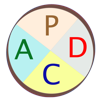
에 의해 게시 에 의해 게시 APPSKOUSIKA SOTWARE DEVELOPERS (OPC) PRIVATE LIMITED
1. One can envision an open coil spring, with each loop being one cycle of the scientific method - PDCA, and each complete cycle indicating an increase in our knowledge of the system under study.
2. In the United States a PDCA approach is usually associated with a sizeable project involving numerous people's time, and thus managers want to see large 'breakthrough' improvements to justify the effort expended.
3. When a pass through these four steps does not result in the need to improve, the scope to which PDCA is applied may be refined to plan and improve with more detail in the next iteration of the cycle.
4. PDCA should be repeatedly implemented in spirals of increasing knowledge of the system that converge on the ultimate goal, each cycle closer than the previous.
5. PDCA (plan–do–check–act) is an iterative four-step management method used in business for the control and continuous improvement of processes and products.
6. Study the actual results (measured and collected in "DO" above) and compare against the expected results (targets or goals from the "PLAN") to ascertain any differences.
7. However, the scientific method and PDCA apply to all sorts of projects and improvement activities.
8. Especially at the start of a project, key information may not be known; the PDCA—scientific method—provides feedback to justify our guesses (hypotheses) and increase our knowledge.
9. Charting data can make this much easier to see trends over several PDCA cycles and in order to convert the collected data into information.
10. PDCA allows for major 'jumps' in performance ('breakthroughs' often desired in a Western approach), as well as Kaizen (frequent small improvements).
11. Establish the objectives and processes necessary to deliver results in accordance with the expected output (the target or goals).
호환되는 PC 앱 또는 대안 확인
| 앱 | 다운로드 | 평점 | 개발자 |
|---|---|---|---|
 PDCA PDCA
|
앱 또는 대안 다운로드 ↲ | 0 1
|
APPSKOUSIKA SOTWARE DEVELOPERS (OPC) PRIVATE LIMITED |
또는 아래 가이드를 따라 PC에서 사용하십시오. :
PC 버전 선택:
소프트웨어 설치 요구 사항:
직접 다운로드 가능합니다. 아래 다운로드 :
설치 한 에뮬레이터 애플리케이션을 열고 검색 창을 찾으십시오. 일단 찾았 으면 PDCA 검색 막대에서 검색을 누릅니다. 클릭 PDCA응용 프로그램 아이콘. 의 창 PDCA Play 스토어 또는 앱 스토어의 스토어가 열리면 에뮬레이터 애플리케이션에 스토어가 표시됩니다. Install 버튼을 누르면 iPhone 또는 Android 기기 에서처럼 애플리케이션이 다운로드되기 시작합니다. 이제 우리는 모두 끝났습니다.
"모든 앱 "아이콘이 표시됩니다.
클릭하면 설치된 모든 응용 프로그램이 포함 된 페이지로 이동합니다.
당신은 아이콘을 클릭하십시오. 그것을 클릭하고 응용 프로그램 사용을 시작하십시오.
PC 용 호환 APK 받기
| 다운로드 | 개발자 | 평점 | 현재 버전 |
|---|---|---|---|
| 다운로드 PC 용 APK » | APPSKOUSIKA SOTWARE DEVELOPERS (OPC) PRIVATE LIMITED | 1 | 2.2 |
다운로드 PDCA Mac OS의 경우 (Apple)
| 다운로드 | 개발자 | 리뷰 | 평점 |
|---|---|---|---|
| $2.99 Mac OS의 경우 | APPSKOUSIKA SOTWARE DEVELOPERS (OPC) PRIVATE LIMITED | 0 | 1 |
PDCA (plan–do–check–act) is an iterative four-step management method used in business for the control and continuous improvement of processes and products. It is also known as the Deming circle/cycle/wheel,Shewhart cycle, control circle/cycle, or plan–do–study–act (PDSA). The steps in each successive PDCA cycle are : PLAN Establish the objectives and processes necessary to deliver results in accordance with the expected output (the target or goals). By establishing output expectations, the completeness and accuracy of the specification is also a part of the targeted improvement. When possible start on a small scale to test possible effects. DO Implement the plan, execute the process, make the product. Collect data for charting and analysis in the following "CHECK" and "ACT" steps. CHECK Study the actual results (measured and collected in "DO" above) and compare against the expected results (targets or goals from the "PLAN") to ascertain any differences. Charting data can make this much easier to see trends over several PDCA cycles and in order to convert the collected data into information. Information is what you need for the next step "ACT". ACT Request corrective actions on significant differences between actual and planned results. Analyse the differences to determine their root causes. Determine where to apply changes that will include improvement of the process or product. When a pass through these four steps does not result in the need to improve, the scope to which PDCA is applied may be refined to plan and improve with more detail in the next iteration of the cycle. PDCA should be repeatedly implemented in spirals of increasing knowledge of the system that converge on the ultimate goal, each cycle closer than the previous. One can envision an open coil spring, with each loop being one cycle of the scientific method - PDCA, and each complete cycle indicating an increase in our knowledge of the system under study. This approach is based on the belief that our knowledge and skills are limited, but improving. Especially at the start of a project, key information may not be known; the PDCA—scientific method—provides feedback to justify our guesses (hypotheses) and increase our knowledge. Rather than enter "analysis paralysis" to get it perfect the first time, it is better to be approximately right than exactly wrong. With the improved knowledge, we may choose to refine or alter the goal (ideal state). Certainly, the PDCA approach can bring us closer to whatever goal we choose. Rate of change, that is, rate of improvement, is a key competitive factor in today's world. PDCA allows for major 'jumps' in performance ('breakthroughs' often desired in a Western approach), as well as Kaizen (frequent small improvements). In the United States a PDCA approach is usually associated with a sizeable project involving numerous people's time, and thus managers want to see large 'breakthrough' improvements to justify the effort expended. However, the scientific method and PDCA apply to all sorts of projects and improvement activities.
ZOOM Cloud Meetings
알바몬 - 알바 채용 전문
알바천국
모바일팩스 i
병무청
취업은 잡코리아
병무청 간편인증
사람인-인턴, 신입의 취업부터 경력직 이직 커리어까지

Google Meet
Microsoft Teams
블라인드 Blind
배민커넥트 - 배달할 땐 누구나
엔카-중고차 1위 플랫폼 Encar 내차팔기, 내차시세
통화 녹음기 및 녹음기-가장 간단한 통화 녹음 소프트웨
아이폰 통화 녹음 및 음성 녹음